Hi! It sure has been a while, hasn’t it? I’ve been super busy recently with college courses and working towards transferring to UMass Amherst from Middlesex Community College!
A few weeks back, I was invited to participate in the CCIC (Community College Innovation Challenge), and to help design and present a business pitch for an innovative product. Our team decided to pitch a pair of sleek headphones that use a fusion of LiDAR, camera, and AI technology to help blind people navigate the world. This blog post won’t go in-depth on the technical working of the headphones, as all I was tasked with was designing a model in Blender to give a visual to potential investors. Having some experience in Blender, I knew I could rise to the challenge, however, this was a project like I had never before done in Blender – A pretty looking render of a product for investors to gawk at.
Here’s the press release for our CCIC project, InSight (Middlesex Community College): https://www.aaccinnovationchallenge.com/wp-content/uploads/2025/04/2025CCICNationalFinalistsPressRelease_Final.pdf
How’d I do it? What was my thought process throughout the design process? Keep reading to find out.
Step 1: Identify Deliverables
My team requested the render to be an exploded view of one side of the headphones. A view such as this necessitates careful modeling of every part that goes into making a pair of headphones work, including the extra technology necessary for the LiDAR and cameras!

Our team determined that the LiDAR and cameras would be mounted to the sides of the headphones with a servo motor to pivot the sensors 90° up and down (to keep the sensors level if the person is looking up/down). This design constraint meant I would have to design some sort of pivot bracket and LiDAR mount, as well as space for a small servo, in order for the render to be realistic and accurate.
Furthermore, we determined that in order to allow audio passthrough more easily, the headphones would have an open end and the speaker would wrap around the person’s ear. I’ve included a reference image, as the concept is somewhat difficult to explain.

My design timeline looked a bit like this:
- Design a basic pair of open-ear headphones in Blender
- Explode one side of the headphones and fill in missing geometry
- (Roughly) design interior mechanics to resemble the inner workings of a pair of headphones
- Design LiDAR/camera mount and bearing that mates mount to headphone
- Design servo motor and include in render
Learning Basic Modeling Skills
In order to learn how to use a program like Blender, which can be very, very overwhelming when first opened, I followed Blender Guru’s Blender Tutorial to kickstart my knowledge of the platform. Part of my knowledge from Fusion transferred over to Blender, such as vertex, edge, and plane definitions, basic movement, and basic modeling skills.
Within no time, I had a render complete:

While this render looks okay, it’s very basic and just isn’t that appealing to look at. My main issue with this render is how thin the headphone’s shell is, as well as the strange shape of the LiDAR. Keeping this in mind, it was time for:
Revision B
After a couple botched practice renders and some research on how to make things in Blender actually look pretty, I settled on my Revision B, the model below:


Closing Thoughts
While our team didn’t end up winning the CCIC, I am honored to have been part of such an incredible team of people, and to have been able to work alongside them on this project. Teaching myself Blender at a more detailed level was tons of fun and a great learning experience for me. Regardless of our ranking in the competition, I learned a ton from this experience and would absolutely do something like it again.
Thanks so much for reading!
-Marcelo





Leave a Reply